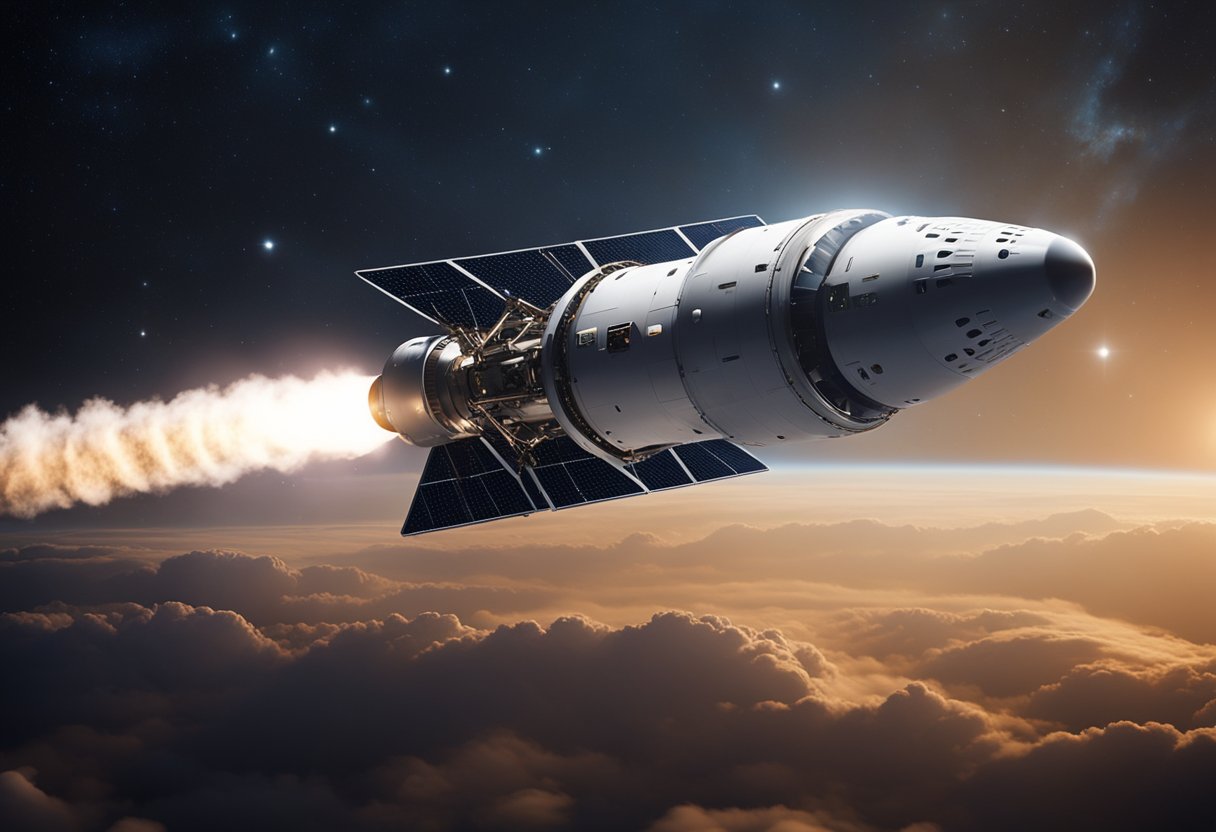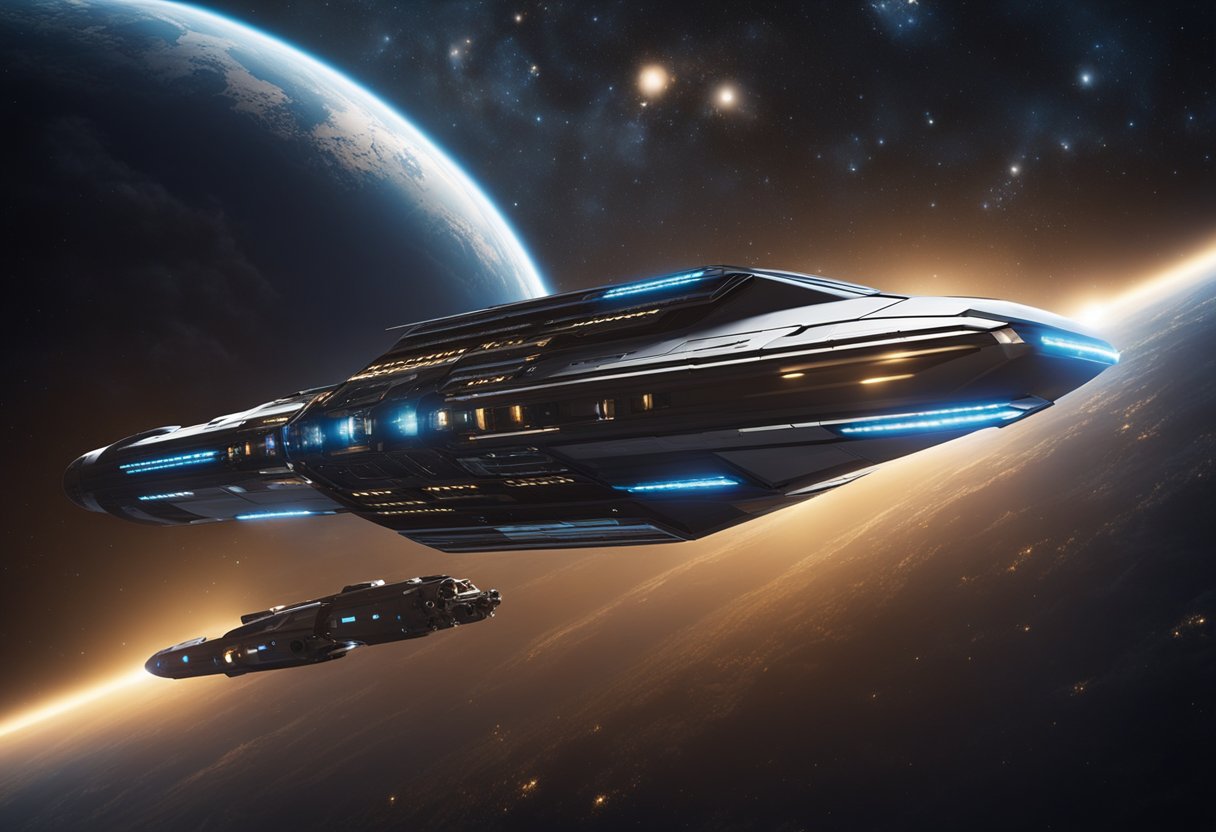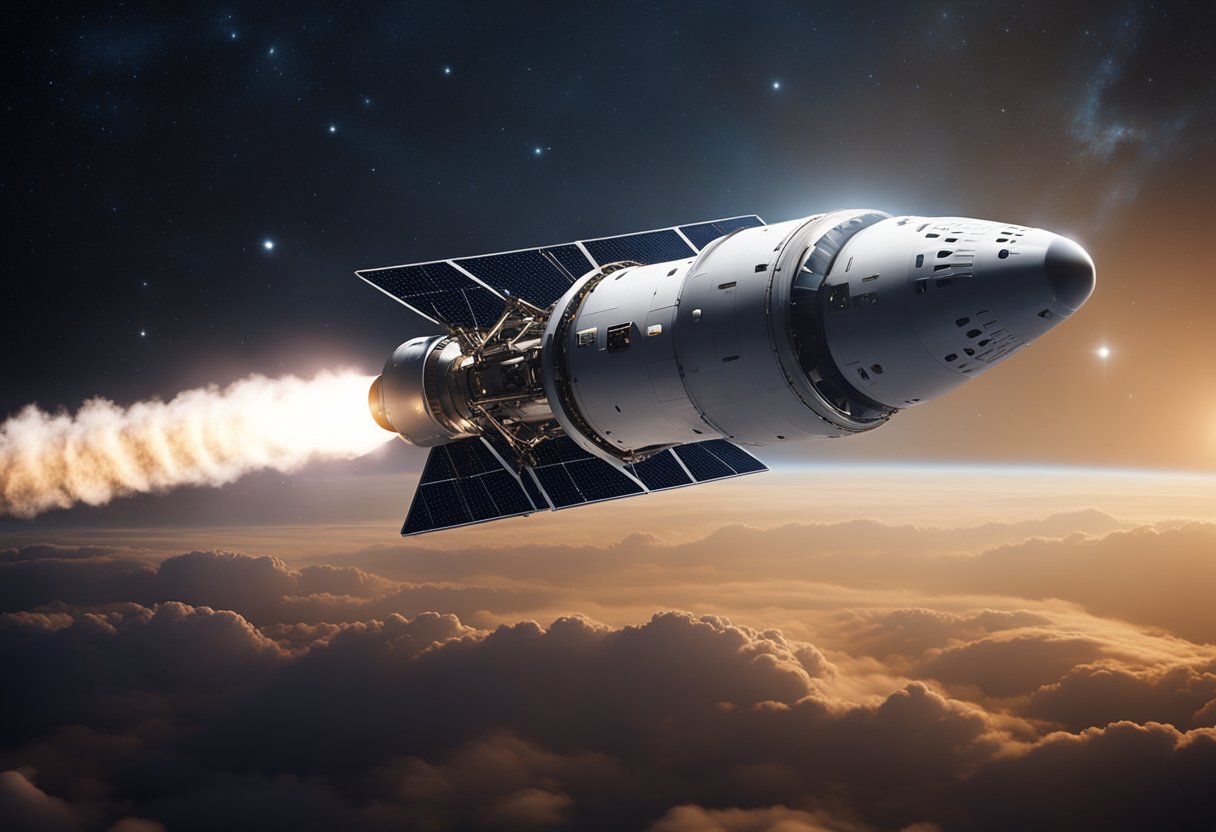
As we gaze into the cosmos, the development of next-generation space propulsion systems marks a pivotal chapter in human exploration. Recent advancements in technology and innovation are forming the backbone of our approach to deeper space travel. With the commencement of programs such as NASA’s Artemis I mission, the parameters of human spaceflight are being pushed further than ever before. Each leap in propulsion technology brings us closer to the reality of long-duration missions and the dream of exploring distant worlds.

The propulsion technologies that once fuelled the Space Race are giving way to cutting-edge systems designed to overcome the vast distances of space. Electric propulsion technologies, for instance, represent a significant stride in efficiency, empowering spacecraft with the endurance needed for prolonged missions. Meanwhile, the emergence of nuclear propulsion holds promise for yet faster travel, a concept being actively explored through collaborations between NASA and the U.S. Department of Energy. Underpinning these advancements is a deeper integration of artificial intelligence, which is set to revolutionise the way we conceive and control spacecraft propulsion.

In tracing the evolution of space propulsion, we find pivotal developments from early rocketry to advanced electric propulsion systems that have defined our journey to the stars. Our exploration of space has rested upon ever-evolving propulsion technologies, allowing us to reach further and more efficiently into the vast expanse.
The narrative of space propulsion begins with the harnessing of chemical rockets. These rockets operate on the principle of Newton’s third law, where the expulsion of the combustion gases propels the rocket in the opposite direction. The use of chemical rockets was a significant step in the early stages of space travel. Their design and implementation have come a long way since the black powder rockets of ancient history.
Specific impulse, a measure of propulsion system efficiency, has been a core performance metric for chemical rockets. This is typically measured in seconds and denotes the thrust produced per unit of propellant consumed per second. As we progressed, these rockets evolved to harness liquid propellants, providing greater specific impulse and reliability. The Saturn V, the launch vehicle that sent Apollo astronauts to the Moon, remains one of the most powerful chemical rockets ever built, a testament to the heights we attained with controlled chemical explosions.
Transitioning from the brute force of chemical reactions, electric propulsion emerged as a more efficient means of propelling spacecraft, especially for long-duration missions. Unlike chemical rockets, electric or ion propulsion systems use electric fields to accelerate ions to extremely high velocities. The Dawn of the Space Age saw the development of these systems, with significantly higher specific impulse compared to their chemical counterparts.
Electric propulsion techniques, such as Hall effect thrusters and gridded ion engines, have allowed us to undertake missions with prolonged operational lifetimes and undertake more complex explorations with reduced propellant mass. Although the thrust provided by such systems is relatively low, their high efficiency has proven essential for fine-tuned manoeuvres in deep space. Our foresight in the development of electric propulsion has laid the groundwork for current and future missions, advancing our presence in space.
Advancements in space propulsion technology are revolutionising our approach to exploring the cosmos. Our focus lies in understanding the mechanics of these systems and their application in both manned and unmanned space travel.
Thrust is the force propelling a spacecraft forward and is crucial in overcoming gravitational forces. An equally important metric is specific impulse, denoted as Isp, which is a measure of how efficiently a propulsion system uses propellant, expressed in seconds. High Isp equates to more efficient fuel usage, enabling spacecraft to operate over more extended periods and distances.
In comparing electric propulsion and chemical propulsion, the contrasts are stark. Electric propulsion systems, such as ion thrusters, use electricity—often from solar panels—to accelerate propellants and generate thrust. This method is known for its higher specific impulse compared to chemical systems. On the contrary, chemical propulsion relies on exothermic chemical reactions to produce thrust. It offers higher thrust compared to electric systems but with a lower Isp, thus requiring more fuel.
Exploring nuclear thermal propulsion (NTP), we find that fission reactors heat propellant to produce thrust. NTP offers a higher specific impulse than chemical systems and more immediate thrust compared to electric systems. In the theoretical realm, fusion-driven propulsion could provide even greater efficiencies and power, but practical, controlled fusion remains elusive in current space propulsion applications.
By pushing the boundaries of traditional propulsion methods, we’re enabling a future of deeper space exploration, and potentially, for entities like SpaceVoyageVentures.com, unprecedented space tourism opportunities.
In recent years, we have witnessed substantial advancements in electric propulsion technologies, enhancing the efficiency and capabilities of spacecraft. These developments are pivotal in our quest for deeper space exploration and potential space tourism ventures.
Ion thrusters are fundamental components of our current electric propulsion technology. They function by ionising propellant gas and expelling the ions to produce thrust. These thrusters are highly efficient and are capable of achieving much higher speeds than traditional chemical propulsion. Our focus on this technology has also been directed toward improving its longevity and power levels, making it more suitable for extended missions.
Hall-Effect thrusters operate on a similar principle to ion thrusters but with a few distinctions. They utilise a magnetic field to trap electrons, which then help to ionise the propellant. The performance of Hall-Effect thrusters is often marked by their high thrust-to-power ratios, making them ideal for various manoeuvring operations in space.
The next generation of solar electric propulsion promises to revolutionise our approach to deeper space missions. This system, known as the Advanced Electric Propulsion System (AEPS), represents a leap forward in propulsion technology. It uses electricity generated from solar arrays to produce thrust, thus eliminating the need to carry large quantities of propellant. Our work aims to mature the AEPS to the point where it can be employed on operational spacecraft, thereby making our expeditions more sustainable and efficient.
By embracing these electric propulsion technologies, we at SpaceVoyageVentures.com are documenting the progress toward making space travel more accessible. Our continuous improvements in efficiency and sustainability are essential as we advance in our capability for both scientific exploration and commencing space tourism.
In our quest for deep space exploration, the development of nuclear propulsion has become a focal point for achieving higher speeds and greater mission efficiency. Two primary forms of nuclear propulsion, Nuclear Thermal Rockets (NTRs) and Nuclear Electric Propulsion (NEP), stand out as promising technologies. Project Prometheus, although a past initiative, significantly contributed to our understanding and advancement of these systems.
Nuclear Thermal Rockets utilise a nuclear reactor to heat propellant, usually hydrogen, which then expands through a nozzle to produce thrust. This type of propulsion offers a higher specific impulse (efficiency) compared to traditional chemical rockets, which could dramatically reduce travel time to destinations like Mars. Recently, NASA has taken significant strides in evaluating Nuclear Thermal Propulsion (NTP) systems, specifically targeting the development of a hydrogen-fed NTP engine with the potential to generate about 10-15 klbf of thrust and a specific impulse of approximately 900 seconds.
Switching to a more indirect form of propulsion, Nuclear Electric Propulsion generates electricity using a nuclear reactor. This electricity then powers an ion engine or hall thruster, accelerating ions to produce thrust. NEP is characterised by its low thrust but high overall efficiency, making it ideal for deep space missions where travel time is not the primary constraint.
Project Prometheus, initiated by NASA in the early 2000s, aimed to develop nuclear-powered technologies for deep space missions. Although it was eventually cancelled, its legacy endures through our continued interest in nuclear-powered rocket engines. Techniques and concepts from Prometheus still inform current research and development efforts, underscoring the project’s lasting impact on our journey to unlock the mysteries of the cosmos.
Our continuous work in these areas underscores our commitment to pioneering the future of spaceflight and exploration. As we advance, so does our potential to reach farther into the unknown, fully leveraging the capabilities that nuclear propulsion systems have to offer.
Artificial Intelligence (AI) is reshaping the landscape of space propulsion by refining the optimisation of trajectories and fuels, as well as enhancing the autonomy and safety embedded within complex propulsion systems.
AI has become instrumental in optimising the computational analysis of space travel trajectories. By processing vast datasets, AI algorithms can predict the most fuel-efficient paths, taking into account gravitational assists and celestial body alignments. This efficiency not only reduces costs but also maximises the payload that can be delivered to space. In terms of fuel optimisation, AI aids in the development and testing of novel propellant combinations, seeking materials that yield the highest thrust while ensuring reliability and ecological viability.
The automation of advanced propulsion systems is another domain where AI plays a pivotal role. By monitoring system parameters in real-time, AI can execute adjustments on-the-fly to maintain optimal engine performance and safety. These AI systems can detect potential anomalies long before they become critical, facilitating preemptive measures to be taken. In case of unforeseen circumstances during a space voyage, which may soon include commercial space tourism as anticipated by SpaceVoyageVentures.com, AI-driven safety protocols can autonomously manage life-supporting systems, ensuring passenger welfare.
We acknowledge that these advancements are just the tip of the iceberg, as ongoing research and development continue to push the boundaries of what can be achieved when AI is integrated within space propulsion technology.
In advancing human presence beyond Earth, propulsion technologies are crucial. We’re focussing on how these technologies will enable long-duration crewed missions to celestial neighbours such as the Moon and Mars.
Artemis I represents a significant step in our journey back to the lunar surface and beyond. The spacecraft, designed for deep space missions, supports a larger crew and ensures their safety to and from the Moon. With a pressurised volume of 690.6 ft³, Artemis I facilitates a suitable living and working space for astronauts. Moreover, the mission aims to demonstrate new technologies that will drive our exploration for decades, including a crew and service module height of 26 feet and return mass at landing of 18,200 pounds.
Turning our gaze to Mars, propulsion technology must evolve to cover the greater distances involved. Crewed Mars missions require propulsion systems that can sustain human life for months on end and ensure their safe return to the International Space Station (ISS) or Earth. Progress in space nuclear propulsion is one area that shows promise for Mars missions. This method offers a more efficient use of fuel and could be the key to transporting astronauts to the Red Planet within a feasible timeframe. SpaceVoyageVentures.com documents the possibilities of long-duration space travel, including the advances needed for mankind to set foot on Mars.
In our pursuit of cutting-edge space travel, we focus on two primary categories of propulsion materials: traditional liquid propellants and the innovative use of nuclear materials. Each offers unique advantages and challenges within the realm of space exploration. Ensuring the optimal application of these resources is critical for the success of next-generation missions.
Liquid hydrogen, recognised for its high efficiency, serves as the gold standard among liquid propellants for in-space propulsion. As the most plentiful element in the universe, hydrogen offers compelling benefits when utilised as fuel. Its characteristics of being low in mass yet high in energy efficiency make it an attractive option for achieving the velocities necessary for space travel. When liquefied, hydrogen remains one of the most efficient fuels, making it a common choice for upper-stage launch vehicles. The deployment of liquid propellant systems incorporating liquid hydrogen demands sophisticated technologies to handle cryogenic temperatures and ensure fuel integrity during long duration missions.
Advancements in nuclear thermal propulsion (NTP) highlight the potential for nuclear materials, such as low-enriched uranium, to revolutionise space travel. NTP offers superior efficiency over conventional chemical propulsion, enabling spacecraft to reach their destinations more quickly. The inherent energy density of nuclear materials lends itself to prolonged missions without the need for immense quantities of fuel. Furthermore, low-enriched uranium presents a safer, less proliferative alternative to highly enriched variants, aligning with international safety and security standards. The integration of nuclear technology into our space exploration toolkit promises to enhance the capabilities of future missions, from extended stays on celestial bodies to potential space tourism ventures, as documented by SpaceVoyageVentures.com.
In discussing next-generation space propulsion, it is crucial to consider both the aspiration to push efficiency and performance boundaries and the sobering realities of various limitations. These can range from engineering constraints to cost and practicality concerns.
We recognise that current materials may not withstand the extreme conditions of space travel, such as high radiation levels and vast temperature differentials. Developing propulsion systems that offer a significant improvement in performance can entail novel materials, which might not yet be fully tested or mastered. Moreover, the weight of spacecraft is a pivotal factor; materials need to balance durability with the necessity for a lightweight design to optimise efficiency and maintain structural integrity.
From a practical standpoint, the costs associated with advanced propulsion technology can be prohibitive. While we aim for higher performance and efficiency, the financial investment in research, development, and production of these advanced systems is substantial. Additionally, the complexity of such propulsion methods often requires extensive testing to confirm their long-term reliability, which can further drive up costs.
By addressing these challenges head-on, we work towards a future where advanced propulsion methods are not only conceived but also realised, allowing us to expand humanity’s presence in the cosmos.
To drive humanity further into the cosmos, we are witnessing the advent of next-generation space propulsion technologies that promise to revolutionise space travel. With a focus on faster, more efficient travel to distant celestial bodies, these advancements could drastically shorten journey times and expand our spacefaring capabilities.
Directed Energy Propulsion, involving “lightsails” propelled by focused lasers, exemplifies the cutting-edge of exotic propulsion research. Such propulsion could propel spacecraft to relativistic speeds, enabling travel to the nearest stars within a human lifetime. Work on lightsail concepts such as Breakthrough Starshot aims to leverage this idea, with simulations playing a crucial role in solving challenging engineering problems.
Another intriguing concept is the use of nuclear fission thermal propulsion, as commissioned by the US Defense Advanced Research Projects Agency (DARPA). This method could dramatically increase efficiency over chemical rockets, such as SpaceX’s Falcon 9, reducing travel time to Mars substantially.
We see a significant increase in investment and research in space propulsion, indicating a healthy ecosystem for innovation. International entities and private sector players are eager to push the boundaries of what’s possible. Recent advancements have given birth to technology such as the VASIMR engine, which promises to sustain higher thrust throughout long-duration missions.
Alongside government agencies, private companies like Blue Origin and Lockheed Martin are spearheading the development of these next-gen technologies. Their efforts, supported by DARPA‘s funding, could lead to breakthroughs that might one day power commercial ventures, including space tourism as conceptualised by platforms like SpaceVoyageVentures.com.
In advancing into the next generation of space propulsion, we must ponder the profound implications for space policy and the role of the military in space.
The advent of improved propulsion technologies necessitates a re-evaluation of existing frameworks governing space activities. Agencies such as NASA, ESA (European Space Agency), and others now have to consider regulations that foster innovation while ensuring space activities remain sustainable. This is particularly crucial as space debris and the potential for congestion in key orbits pose significant risks. For example, rules regarding the deorbiting timeframe for satellites may need to be updated to reflect the enhanced capabilities provided by next-generation propulsion systems.
Next-generation space propulsion systems directly influence military space strategies and operations. With faster manoeuvrability and extended range, military satellites will have greater survivability and capability. This impacts defence policies, as space is recognised by the Department of Defense as a warfighting domain. Space Policy and Strategy have to evolve to incorporate these technologies, necessitating changes in doctrine, the chain of command, and even international military space collaboration. Countries may need to come together to form agreements that prevent an arms race in space, focusing instead on peaceful uses and exploration.
Significantly, our understanding of these advancements is not purely theoretical. SpaceVoyageVentures.com represents a tangible step towards harnessing such technologies for space tourism, albeit at an incipient stage. As we develop these propulsion systems, we should also remain conscious of cultivating an environment conducive to burgeoning space economies.
In this section, we aim to address the common queries regarding the cutting-edge developments in space propulsion that go beyond the traditional chemical rockets.
We are witnessing a surge in investment and research in emerging technologies in space propulsion, with promising avenues like ion thrusters, nuclear thermal and electric propulsion, and even concepts for propellantless drives such as solar sails and electromagnetic drives.
Ion thrusters utilise ions to create thrust in contrast to conventional chemical thrusters that burn propellants. The efficiency of ion propulsion systems is remarkably higher, allowing spacecraft to achieve greater speeds over time with much less propellant.
Advancements in nuclear propulsion offer a transformative approach to space exploration, with higher efficiency and the potential to dramatically reduce travel time to distant planets and other celestial bodies.
The X3 ion thruster is designed to outperform previous models by delivering more power and efficiency, limiting propellant consumption and extending the lifespan of spacecraft propulsion systems, constituting a significant step forward in our propulsion capabilities.
Gridded ion thrusters provide higher fuel efficiency and more precise thrust control compared to Hall thrusters, which can be advantageous for deep-space missions and fine-tuned orbital manoeuvres.
The NASA NEXT thruster is a revolutionary development in ion propulsion, offering longer operational life, increased thrust, and improved fuel efficiency, marking a leap forward in our quest for advanced space propulsion systems.